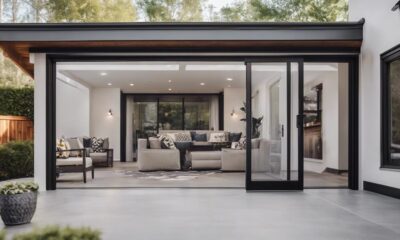Architecture Home Styles
Why People Do Enjoy Gothic Literature Explained
Bask in the enigmatic allure of Gothic literature as we unravel the secrets behind its enduring fascination, beckoning you to explore further.

As we navigate the shadowy corridors of Gothic literature, we are drawn to its enigmatic allure like moths to a flickering flame. The genre's ability to unearth the depths of human nature and confront the darkest corners of the mind beckons us to explore further.
However, what truly captivates us lies beneath the surface, hidden within the intricate tapestry of themes and emotions waiting to be unraveled. Join us as we uncover the secrets behind the enduring fascination with Gothic literature and unravel the mysteries that lie within its pages.
Key Takeaways
- Gothic literature captivates with dark settings and mysterious elements, creating suspense and unease.
- Characters delve into hidden desires and darker traits, reflecting psychological exploration.
- Exploration of mortality, decay, and forbidden desires prompts contemplation and catharsis.
- Thrilling suspense and impending doom keep readers engaged, adding an eerie charm to Gothic literature.
The Allure of Dark and Mysterious Settings
Dark and mysterious settings in Gothic literature captivate readers with their ominous charm, immersing them in a world of foreboding and intrigue. Gothic fiction often employs haunted houses, ancient castles, and remote locations shrouded in mystery to create an atmosphere of horror and suspense. These Gothic elements enhance the sense of unease and tension, drawing readers into the eerie and gloomy environments that permeate the narrative.
The allure of these dark and mysterious settings lies in their ability to evoke a haunting beauty that appeals to our fascination with the macabre. The gothic aesthetics present in these settings contribute to the genre's atmospheric storytelling experience, enveloping readers in a world where the line between reality and the supernatural is blurred.
Psychological Depth of Characters

Exploring the intricate inner worlds of characters in Gothic literature reveals a fascinating tapestry of psychological depth, shedding light on their hidden desires, inner conflicts, and haunting past experiences.
Within the realm of Gothic literature, characters often embody a myriad of psychological traits that unveil the darker aspects of human nature. These characters grapple with inner conflicts that stem from guilt, obsession, and madness, offering a profound exploration of the complexities of the human psyche.
The psychological depth of these characters serves to create a chilling sense of unease and suspense, drawing readers into their twisted perceptions and vulnerabilities. Through their fears and distorted realities, Gothic protagonists mirror the inner turmoil that lurks within all individuals, highlighting the impact of past traumas on present actions.
Gothic literature, with its focus on the psychological intricacies of characters, provides a compelling lens through which to examine the profound depths of human nature and the haunting manifestations of the mind.
Themes of Death and Decay
Themes of death and decay permeate Gothic literature, delving into the macabre and morbid aspects of existence with a haunting intensity. In this genre, the exploration of mortality and decay serves as a powerful tool to evoke a range of emotions and provoke deep contemplation. Here's why this theme is crucial:
- Symbolism of Decay: Gothic horror often uses decay as a symbol of the inevitable nature of death, highlighting the transient quality of life.
- Human Fear and Curiosity: The fascination with mortality and decay in Gothic works reflects a profound human fear and curiosity about the unknown.
- Psychological Deterioration: Characters in Gothic literature frequently encounter physical decay in their surroundings, mirroring their own psychological deterioration.
- Contemplation of Existence: By confronting the theme of death and decay, Gothic narratives prompt readers to ponder the fragility of existence and the mysteries of mortality.
Through these elements, Gothic literature creates a chilling atmosphere that captivates audiences and delves into the darker aspects of human experience.
Exploration of Forbidden Desires
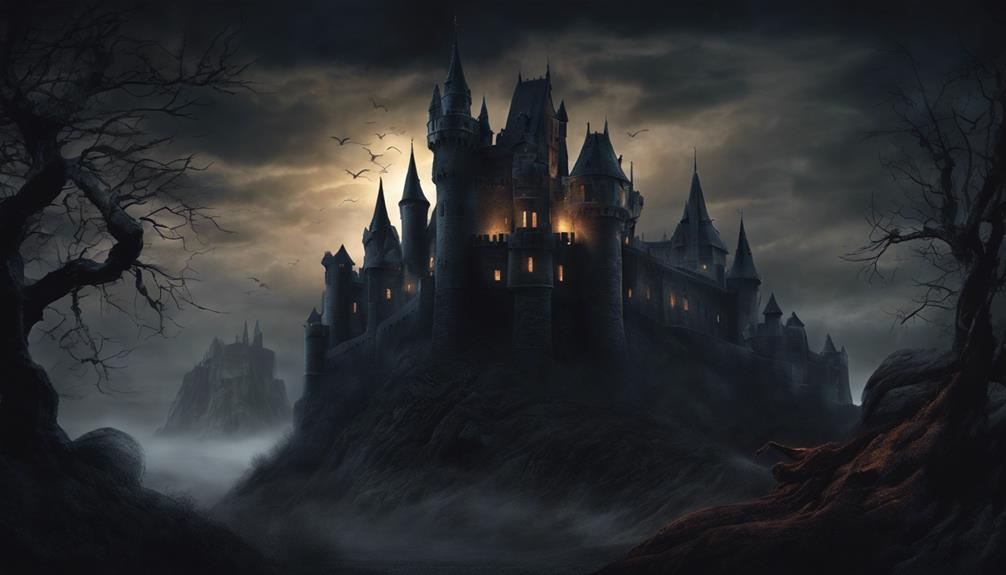
When delving into Gothic literature, one encounters a profound exploration of taboo subjects and forbidden desires that illuminate the darker recesses of human nature.
Gothic literature serves as a vehicle for diving into the forbidden aspects of human desires, those typically suppressed or shunned by societal norms.
Through this genre, readers are offered a safe space to confront these hidden desires, allowing for a cathartic experience that can be both enlightening and liberating.
Sense of Impending Doom and Suspense
The exploration of forbidden desires in Gothic literature seamlessly transitions into a haunting portrayal of impending doom and suspense, intensifying the psychological grip on readers' emotions.
The sense of impending doom in horror stories creates tension and suspense, keeping readers engaged with a thrilling element that heightens their emotional investment in the narrative.
Gothic tales often feature ominous foreshadowing and eerie atmospheres, enhancing the feeling of impending dread and setting a tone of unease.
The anticipation of a looming threat or catastrophe adds a thrilling element to Gothic narratives, captivating readers with an unsettling sense of anticipation.
This theme taps into primal fears, drawing readers into a suspenseful build-up that amplifies the eerie atmosphere and keeps them on the edge of their seats.
The intertwining of impending doom and suspense in Gothic literature contributes to its enduring appeal, offering a rich tapestry of emotions and experiences for those seeking liberation through thrilling storytelling.
Frequently Asked Questions
Why Do People Enjoy Gothic Literature?
We enjoy Gothic literature for its ability to delve into deep fears and societal critiques. The genre's exploration of mortality, darkness, and the supernatural captivates us, offering a unique blend of psychological depth and eerie atmospheres.
Gothic narratives resonate with universal human experiences, drawing readers in with mystery, suspense, and complex character dynamics. Through taboo topics and immersive storytelling, Gothic literature provides a safe space to confront the unknown and embrace the macabre.
How Does Gothic Literature Make You Feel?
Gothic literature envelops us in a chilling embrace, stirring a mix of dread and fascination. The eerie settings and dark themes tap into our deepest emotions, leaving us unsettled yet captivated.
Characters, flawed and intricate, resonate with our own complexities, drawing us into their twisted world. It's a journey through the macabre, a dance with the unknown that both terrifies and enthralls us, offering a cathartic release for our hidden fears and desires.
How Does Gothic Literature Affect People?
Gothic literature affects us by stirring emotions of fear, suspense, and unease through its dark and eerie settings. It engages our minds with themes of death, decay, and the supernatural, crafting a sense of mystery and intrigue.
Psychologically, it offers a cathartic journey to confront inner fears and anxieties in a secure environment. The genre reflects societal concerns, providing a platform to critique conventional values and express Romantic ideals in a somber, atmospheric backdrop.
What Is the Obsession of Gothic Novels?
The obsession with Gothic novels is multifaceted. Readers are drawn to the dark themes, mysterious atmospheres, and psychological depths explored within these works.
Elements like haunted houses, supernatural occurrences, and eerie settings create suspense and intrigue, captivating audiences. Gothic literature provides a safe space to confront fears, desires, and societal anxieties in a controlled, fictional setting.
Its timeless themes of death, decay, romance, and the supernatural continue to resonate with readers, transcending generations.
Conclusion
In conclusion, the enduring appeal of Gothic literature lies in its ability to delve into the depths of human emotions and fears, providing a cathartic experience for readers.
While some may argue that the genre's dark themes can be unsettling, it's through confronting these taboo topics that we're able to gain a deeper understanding of ourselves and the world around us.
Gothic literature serves as a mirror reflecting our innermost desires, fears, and complexities, making it a truly timeless and captivating genre.
- About the Author
- Latest Posts
Introducing Ron, the home decor aficionado at ByRetreat, whose passion for creating beautiful and inviting spaces is at the heart of his work. With his deep knowledge of home decor and his innate sense of style, Ron brings a wealth of expertise and a keen eye for detail to the ByRetreat team.
Ron’s love for home decor goes beyond aesthetics; he understands that our surroundings play a significant role in our overall well-being and productivity. With this in mind, Ron is dedicated to transforming remote workspaces into havens of comfort, functionality, and beauty.
Architecture Home Styles
How to Look for a Good Architect: What You Should Know
Fascinated by the idea of finding the perfect architect? This article unveils key insights on what to consider in your search.
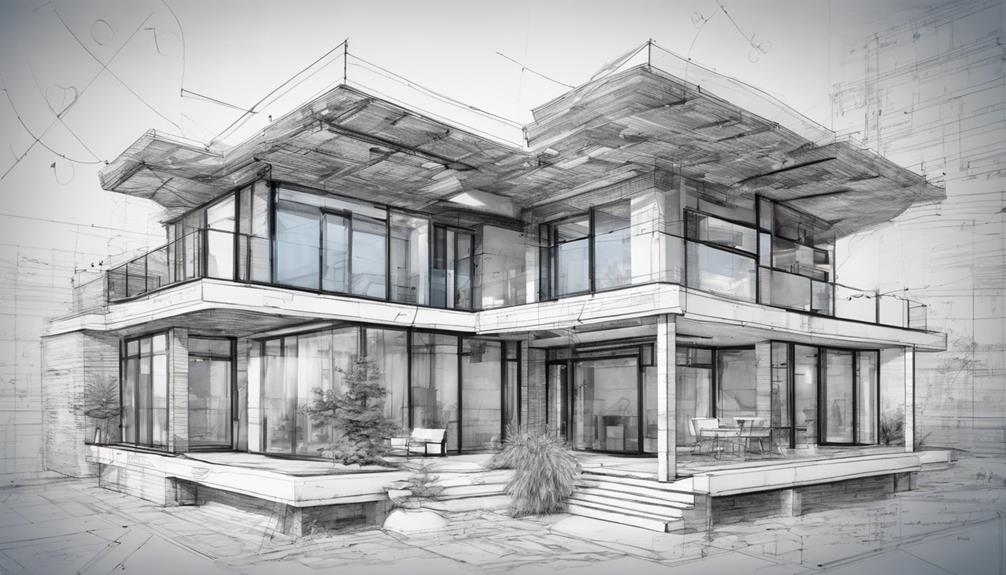
When I think about finding a good architect, it's like searching for the perfect puzzle piece to complete a masterpiece – each angle and curve must fit just right.
Recently, we stumbled upon an intriguing discussion about this very topic. The process of selecting an architect involves more than just browsing portfolios.
Stay tuned to discover the key aspects of identifying that perfect match for your architectural project.
Key Takeaways
- Verify qualifications like a professional degree and state license for expertise and compliance.
- Review experience, portfolio, and client satisfaction for design quality and versatility.
- Ensure effective communication and alignment of visions for successful collaboration.
- Understand budget, fee structure, and contract terms to align financially with the architect.
Qualifications and Credentials
When selecting an architect, we prioritize qualifications and credentials to ensure expertise and adherence to industry standards. It's crucial to verify if the architect holds a professional degree in architecture, such as a Bachelor of Architecture or a Master of Architecture, indicating a strong educational foundation.
Additionally, checking for a valid license to practice in your state is essential to guarantee compliance with local regulations and standards, providing confidence in the architect's capabilities.
Considering architects with certifications like LEED (Leadership in Energy and Environmental Design) showcases a commitment to sustainable design practices and expertise in environmentally conscious projects.
Membership in professional organizations such as the American Institute of Architects (AIA) demonstrates a dedication to ethical standards and ongoing education within the field. These affiliations can indicate a level of professionalism and accountability that aligns with industry best practices and ensures a higher level of quality in the architectural services provided.
Experience and Portfolio
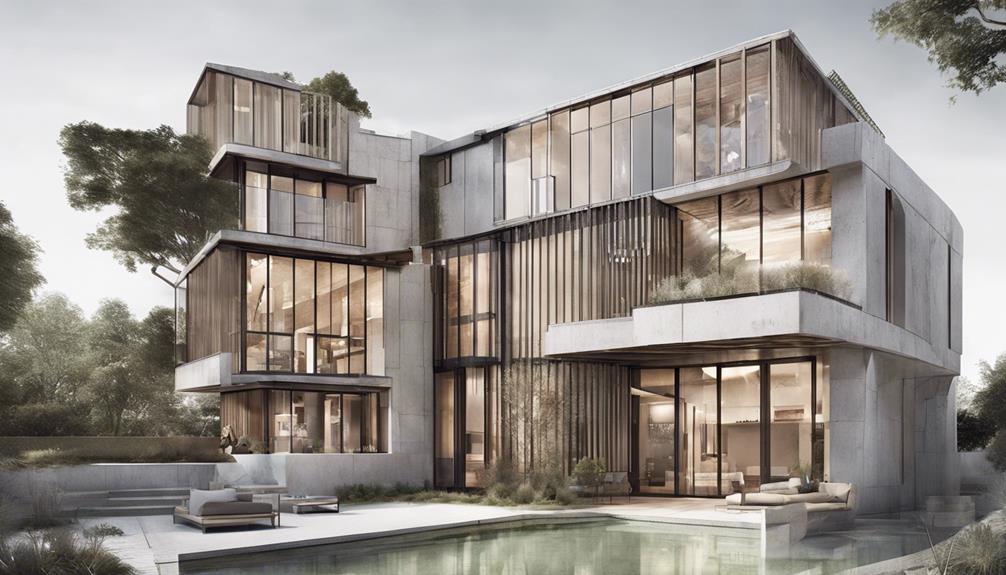
To truly assess the quality and capabilities of an architect, it's imperative to thoroughly examine their experience and portfolio, as these aspects provide valuable insights into their design expertise and ability to deliver on client expectations. When evaluating an architect's experience and portfolio, consider the following key points:
- Experience: Review the architect's years in practice, types of projects completed, and areas of specialization to gauge their level of expertise.
- Design Style and Creativity: Assess their portfolio to understand their unique design style, creativity, and how they cater to client needs effectively.
- Versatility: Look for a diverse portfolio showcasing a range of project sizes, styles, and complexities to evaluate the architect's versatility in design.
- Attention to Detail and Client Satisfaction: Consider the architect's past work quality, attention to detail, and ability to address challenges, while also seeking references to understand their communication skills, project management, and overall client satisfaction levels.
Communication Style
Effective communication between an architect and their client is crucial for ensuring project goals are clearly understood and successfully achieved. To maintain a productive relationship, it is essential to have open dialogue and transparent communication. Expressing preferences, concerns, and feedback is vital for creating a collaborative environment that leads to successful project outcomes. Discussing preferred methods of communication with your architect can ensure efficient updates and a smooth flow of information throughout the project. Regular communication plays a key role in addressing any issues promptly, keeping the project on track. By fostering a collaborative environment through transparent communication and open dialogue, both the client and architect can work together effectively towards a shared vision. It is important to address any concerns or preferences promptly to maintain a harmonious and efficient working relationship, ultimately leading to successful project outcomes.
| Open Dialogue | Transparent Communication | Preferred Methods |
|---|---|---|
| Express Preferences | Productive Relationship | Efficient Updates |
| Regular Communication | Address Issues Promptly | Collaborative Environment |
Compatibility and Vision Alignment

Compatibility between a client and an architect hinges on the alignment of their visions and the resonance of their design philosophies. To ensure a successful collaboration, it's crucial to discuss various aspects that contribute to this alignment:
- Communication Styles: Understanding how the architect prefers to communicate and ensuring it aligns with your communication preferences can help streamline the design process.
- Project Goals: Clearly outlining your project goals and ensuring the architect shares a similar vision can lead to a more cohesive design outcome.
- Design Philosophy: Verifying that the architect's design philosophy complements your preferences and project requirements is essential for a harmonious working relationship.
- References and Past Project Reviews: Seeking references and reviewing the architect's past projects can provide insights into their problem-solving approach, design aesthetic, and overall ability to align with clients' visions.
Budget and Fees
When considering architects for a project, understanding the budget and fee structure is imperative to ensure financial expectations align with the scope of work. Architectural fees can vary significantly, ranging from $2,014 to $8,375 on average. Hourly rates typically fall between $60 to $125, with some architects opting for fixed hourly rates or charging by the square foot.
A common practice is billing a percentage of the construction cost, usually between 5% to 20%. It's crucial for contract terms to be explicit about the scope of work, payment schedule, and any potential additional costs to prevent misunderstandings.
Whether it's for new builds or design development, having a realistic budget in mind and discussing it openly with your architect can lead to a smoother collaboration. By being aware of these key financial aspects, both parties can work towards a successful architectural project within set budget parameters.
Frequently Asked Questions
How Do I Find the Right Architect for Me?
To find the right architect for us, we seek recommendations, explore online resources, review portfolios, visit completed projects, and consider local expertise. Our approach is strategic, ensuring alignment with our vision and the architect's capabilities.
What Are the Tips for Choosing an Architect?
When choosing an architect, we prioritize qualifications, creative compatibility, and transparent communication. Evaluating experience, design philosophy, and budget considerations are key. Establishing a solid foundation with clear expectations is crucial for a successful partnership.
How Do I Find a Reliable Architect?
We find reliable architects by seeking recommendations, using online tools, reviewing portfolios, talking to former clients, considering local professionals, and visiting completed projects. These steps help us assess their work quality, style, and professionalism effectively.
How Do You Know if an Architect Is Good?
When determining an architect's quality, we scrutinize their portfolio, client feedback, professional affiliations, industry recognition, and communication skills. These factors collectively paint a vivid picture of their competence and reliability in delivering exceptional architectural services.
Conclusion
In conclusion, finding the right architect is crucial for the success of your project. Did you know that 72% of clients cite communication as the most important factor in selecting an architect?
By considering qualifications, experience, communication style, compatibility, budget, and fees, you can ensure a smooth and successful collaboration.
Remember, building a strong relationship with your architect is key to bringing your vision to life. Choose wisely and watch your project thrive.
- About the Author
- Latest Posts
Introducing Ron, the home decor aficionado at ByRetreat, whose passion for creating beautiful and inviting spaces is at the heart of his work. With his deep knowledge of home decor and his innate sense of style, Ron brings a wealth of expertise and a keen eye for detail to the ByRetreat team.
Ron’s love for home decor goes beyond aesthetics; he understands that our surroundings play a significant role in our overall well-being and productivity. With this in mind, Ron is dedicated to transforming remote workspaces into havens of comfort, functionality, and beauty.
Architecture Home Styles
How to Do Fibreglass Roofs Need Maintenance?
By understanding the key maintenance practices for fibreglass roofs, you can ensure longevity and prevent costly repairs – discover how in this guide.

As professionals in the roofing industry, we have observed that a surprising 85% of fibreglass roof issues could be prevented through proper maintenance. The question on how to do fibreglass roofs need maintenance is a critical one for homeowners and property managers alike.
Understanding the essential tasks involved in caring for fibreglass roofs can significantly impact their performance and longevity. Let's explore the key maintenance practices that can help you safeguard your investment and avoid costly repairs down the line.
Key Takeaways
- Regular maintenance prevents costly repairs and extends the lifespan of fibreglass roofs.
- Timely inspections and repairs help prevent water damage and degradation.
- Cleaning with mild detergent and using specialized repair kits are essential for fibreglass roof care.
- Quality materials and drainage maintenance are key to prolonging the durability of fibreglass roofs.
Importance of Fibreglass Roof Maintenance
Regular maintenance of fiberglass roofs is essential to prevent degradation, cracking, and leaks caused by environmental factors. Fibreglass, also known as GRP (Glass Reinforced Plastic), is durable but not immune to wear and tear. Without proper care, factors like UV exposure can weaken the material, leading to water damage and leaking flat roofs.
Repairing fiberglass roofs can be costly, emphasizing the importance of routine maintenance. Using specialized roofing kits designed for fibreglass can aid in upkeep and early issue detection. Neglecting roof maintenance can result in extensive damage, requiring more significant repairs or even a full roof replacement.
Key Maintenance Tasks for Fibreglass Roofs

To ensure the longevity and performance of fibreglass roofs, meticulous inspection for cracks, holes, and damage is imperative to prevent exacerbation of potential issues.
Here are key maintenance tasks for fibreglass roofs:
- Inspect the roof regularly: Check for any signs of cracks, holes, or damage caused by weather conditions or other factors. Early detection can prevent extensive repairs and water damage in the future.
- Prompt roof repairs: Address any damage promptly using a fibreglass repair kit. Repairing issues swiftly can prevent leaks and structural problems, maintaining the integrity of the roof.
- Ensure proper roof maintenance: Keep the roof clean by washing it with mild detergent and a soft-bristled brush. Regular cleaning not only maintains the appearance of the roof but also helps in identifying any issues that may require attention.
Effective Care Tips for Fibreglass Roofs
Maintaining the integrity and longevity of fibreglass roofs requires diligent care and attention to detail. To effectively care for fibreglass flat roofing and prevent water damage, regular inspections are crucial. Look for cracks, holes, or any signs of damage that could lead to structural issues. Utilize fibreglass repair kits promptly to address any issues and avoid further damage. It's essential to clean the roof surface with a mild detergent and a soft-bristled brush to preserve its appearance. Additionally, trimming vegetation around the roof can prevent damage and maintain the roof's condition. For optimal results and expert handling, consider hiring professionals for maintenance and roof repair tasks. Below is a table summarizing key care tips for fibreglass roofs:
| Care Tips | Description |
|---|---|
| Regular Inspections | Check for cracks, holes, and damage to prevent structural issues. |
| Cleaning | Use mild detergent and a soft brush to maintain the roof's appearance. |
| Repair Kits | Quickly address any damage with repair kits to prevent further deterioration. |
| Vegetation Trimming | Trim trees and plants near the roof to avoid damage to the roof surface. |
| Professional Maintenance | Hire experts for maintenance and repairs to ensure optimal results. |
Prolonging the Lifespan of Fibreglass Roofs
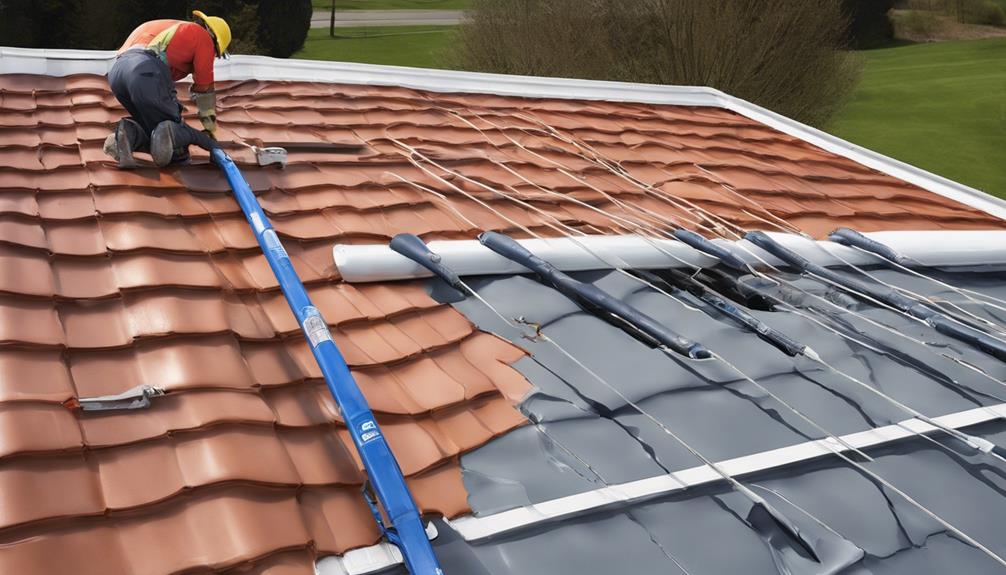
Ensuring the longevity of fibreglass roofs demands meticulous care and proactive maintenance practices. To prolong the lifespan of Fibreglass roofs and prevent issues like water damage and damage to the underlying structure, consider the following:
- Regular Inspections: Schedule routine inspections to identify any signs of damage or wear early on. Addressing these promptly can prevent the need for costly repairs and replacements down the line.
- Proper Drainage Maintenance: Ensure that the drainage system is clear of debris to prevent water ingress and potential water damage. Adequate drainage can significantly extend the lifespan of your GRP Roofing by preventing water-related issues.
- Use Quality Roofing Materials: When repairs or replacements are necessary, opt for high-quality roofing materials. Investing in premium materials can enhance the durability of your fibreglass roof, reducing the frequency of maintenance and prolonging its lifespan.
Preventing Costly Fibreglass Roof Repairs
Regular maintenance and proactive inspections play a crucial role in preventing costly fibreglass roof repairs. By addressing minor issues promptly, such as cracks and leaks, you can prevent water damage and structural issues that may lead to expensive repairs down the line.
Keeping your fibreglass flat roof clean and free of debris is essential in maintaining its integrity and preventing damage that could result in costly repairs. Proactive inspections help in early detection of potential problems, allowing for timely repairs before they escalate into major issues.
Investing in routine maintenance not only helps in preventing leaks and structural damage but also proves to be cost-effective in the long term by extending the lifespan of your fibreglass roof. By prioritizing preventative measures and staying proactive with maintenance and inspections, you can avoid the need for significant roof repairs and ensure the longevity of your fibreglass roof.
Frequently Asked Questions
How Do You Maintain a Fiberglass Roof?
Maintaining a fiberglass roof involves regular inspections for cracks, cleaning with mild detergent, and immediate repair of any damage. Trimming trees and vegetation near the roof can also help prolong its lifespan.
Professionals can provide expert maintenance and repairs. It's crucial to stay proactive with upkeep to ensure the fiberglass roof remains in top condition.
How Do I Protect My Fibreglass Roof?
To protect our fibreglass roof, we can implement proactive measures such as regular inspections and cleaning with a mild detergent. Trimming nearby vegetation and trees can prevent damage.
Quick repairs using fibreglass repair kits maintain the roof's integrity. Hiring professionals for maintenance ensures expert handling.
These steps guarantee optimal protection for our fibreglass roof, extending its lifespan and functionality.
How Do You Recoat a Fibreglass Roof?
When recoating a fibreglass roof, the process involves several key steps:
- Sanding the surface for adhesion
- Priming to enhance bonding
- Applying the new coating evenly
Ensuring a smooth application is essential to prevent drips and ensure even coverage. Once the recoating is complete, it is crucial to allow ample curing time. Regular inspections are also important to detect any wear or damage early on. By maintaining a recoated fibreglass roof, you can ensure its longevity and protect it from environmental elements.
How Long Will a Fiberglass Roof Last?
Fiberglass roofs can last 20-30 years with proper care, potentially up to 50 years with quality installation and regular upkeep. They outlast traditional felt roofs by 10-15 years due to their durability against harsh weather like hail and UV radiation.
The fire-resistant nature also makes them ideal for areas prone to extreme conditions. With minimal impact from weather elements, fiberglass roofs offer longevity and reliability for decades.
Conclusion
In conclusion, maintaining fibreglass roofs is essential for their longevity and performance. Just like tending to a garden to ensure it thrives, regular care and attention to your roof can prevent costly repairs and extend its lifespan.
By taking the time to inspect, clean, and repair as needed, you can protect your investment and enjoy a sturdy and reliable roof for years to come.
Don't wait until the storm hits to realize the importance of proper maintenance!
- About the Author
- Latest Posts
Introducing Ron, the home decor aficionado at ByRetreat, whose passion for creating beautiful and inviting spaces is at the heart of his work. With his deep knowledge of home decor and his innate sense of style, Ron brings a wealth of expertise and a keen eye for detail to the ByRetreat team.
Ron’s love for home decor goes beyond aesthetics; he understands that our surroundings play a significant role in our overall well-being and productivity. With this in mind, Ron is dedicated to transforming remote workspaces into havens of comfort, functionality, and beauty.
Architecture Home Styles
Cheaper Ways to Build With Brick and Concrete
Wander into the world of cost-effective brick and concrete construction techniques and materials, where saving money doesn't mean compromising quality.
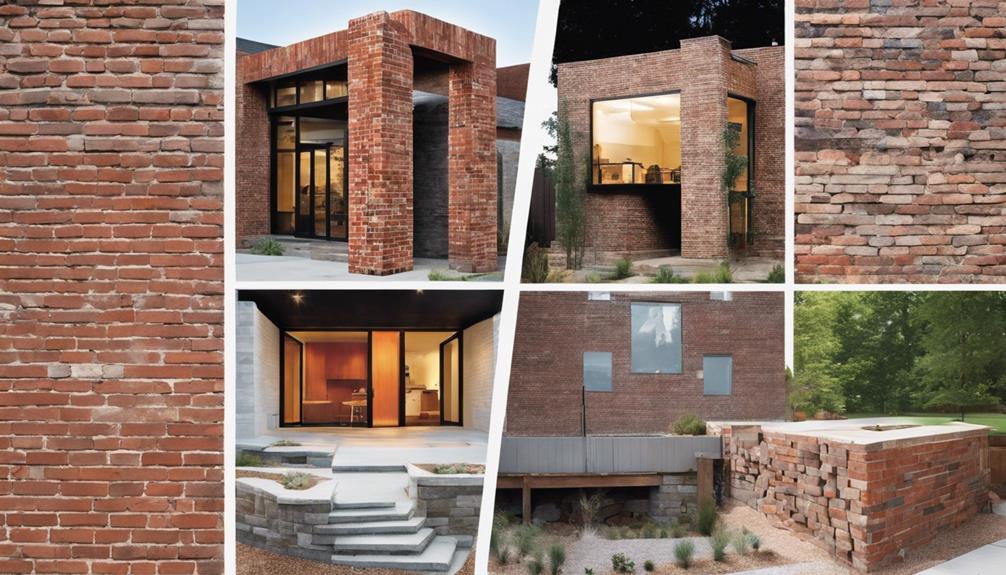
As we laid the foundation for our latest project, we realized that building with brick and concrete doesn't have to break the bank. By exploring innovative techniques and cost-effective materials, we uncovered a wealth of options that can help trim construction expenses without sacrificing quality.
From clever strategies to sustainable choices, the world of affordable brick and concrete construction is vast and full of potential. Stay tuned to discover how you can build your dream structure without draining your budget.
Key Takeaways
- Use compressed earth bricks or concrete blocks for cost-effective construction.
- Opt for interlocking designs and quick installation methods to save money.
- Consider reclaimed bricks or precast concrete panels for significant savings.
- Choose durable, energy-efficient materials like concrete for long-term affordability.
Budget-Friendly Brick Construction Techniques
When constructing on a budget, exploring innovative techniques such as using compressed earth bricks can significantly reduce costs. Compressed earth bricks offer a cost-effective solution for building homes, with each block priced at approximately 33-39 BDT. These masonry units are produced locally, making them an excellent choice for low-cost residential construction projects.
The interlocking design of these bricks, akin to real-life Lego pieces, minimizes the need for mortar while providing robust structural integrity. Made from a blend of lime, cement, and clay that's then compressed using a manual press, compressed earth bricks are ideal for small-scale housing initiatives.
Embracing innovative building systems like compressed earth bricks not only lowers expenses but also introduces an efficient production technology for cost-effective construction. By incorporating these cheap building materials into your construction plans, you can build a sturdy and affordable house without compromising on quality or durability.
Cost-Effective Concrete Building Methods
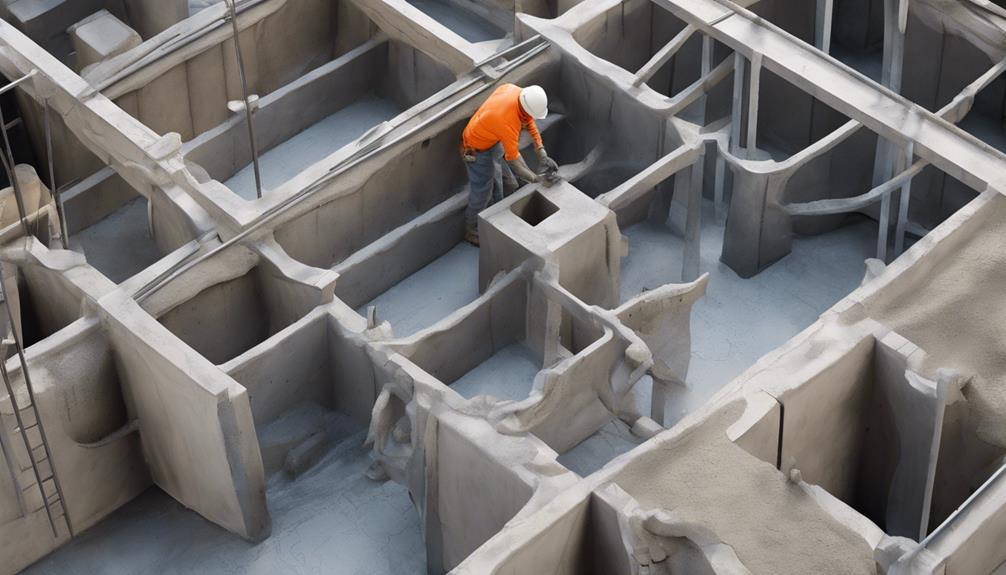
Concrete block construction methods offer a cost-effective solution for building structures due to their affordability and durability. Concrete bricks, priced around 33-39 BDT per block in the market, significantly reduce labor costs with their quick installation and minimal supervision requirements.
Choosing concrete blocks for building your home not only ensures cost-effective construction but also results in low maintenance infrastructure that boasts exceptional longevity and insulation benefits. Market prices for concrete blocks are generally lower than traditional construction materials like red bricks and timber, making them a desirable option for budget-conscious projects.
Additionally, houses constructed with concrete blocks are known to be energy-efficient, consuming 5-9% less energy compared to wooden structures. Embracing cost-effective concrete building methods can lead to efficient, durable, and low-maintenance homes that not only save on initial construction expenses but also offer long-term savings through reduced energy consumption.
Affordable Brick and Concrete Materials
An economical choice for construction projects is the use of affordable brick and concrete materials. When comparing concrete blocks and red bricks, concrete blocks stand out as a more cost-effective option. Concrete blocks typically cost around 33-39 BDT per block, while red bricks range from 8-10 BDT each, showcasing the affordability of concrete blocks. Moreover, concrete blocks offer exceptional durability and insulation properties, reducing long-term maintenance costs. The government's initiative to ban red bricks by 2025 is further boosting the demand for concrete blocks as a viable alternative. In the construction market, concrete blocks also hold a significant advantage over timber, with prices ranging from 500-3000 BDT, solidifying their position as a cost-effective and durable choice. The shift towards concrete blocks not only aligns with the government's regulations but also provides a sustainable and efficient solution for construction needs.
| Concrete Blocks | Red Bricks |
|---|---|
| 33-39 BDT | 8-10 BDT |
| Durability & Insulation | Traditional choice |
| Government-supported alternative | Phasing out by 2025 |
Money-Saving Strategies for Brick Construction
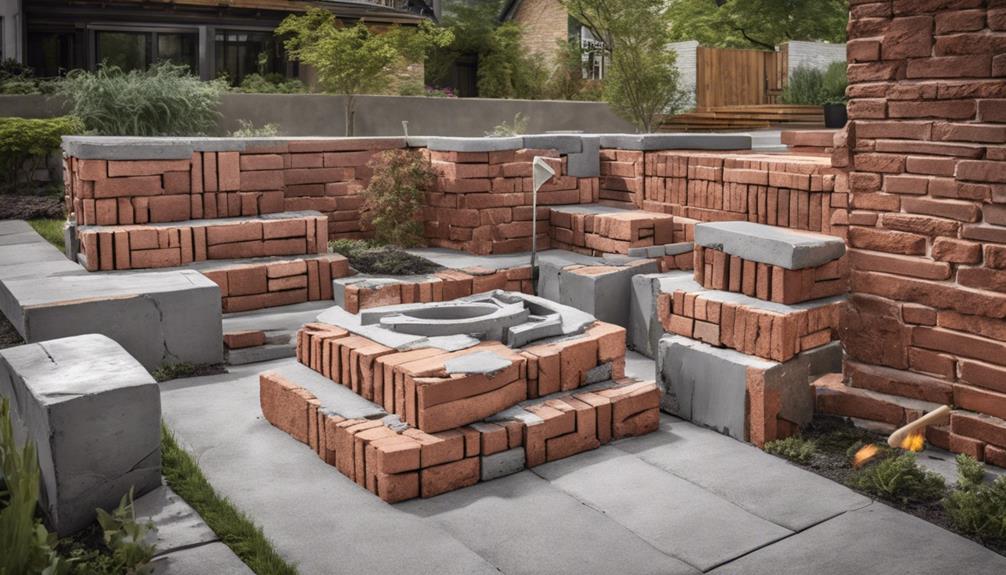
To optimize cost-efficiency in brick construction, exploring money-saving strategies becomes imperative, especially in light of the affordability and durability advantages already highlighted in the discussion on brick and concrete materials.
Utilizing reclaimed bricks presents a substantial opportunity to reduce material costs by up to 50%, offering both economic and environmental benefits.
Opting for standard brick sizes not only minimizes waste but also contributes to lowering overall construction expenses.
Bulk discounts are another avenue to consider, as purchasing bricks in large quantities can lead to significant savings on per-unit costs.
Implementing efficient bricklaying techniques is crucial in streamlining the construction process and decreasing labor expenses.
Additionally, choosing locally sourced bricks can play a pivotal role in cutting down transportation costs while supporting the community.
Frugal Tips for Concrete Building Processes
Our frugal approach to optimizing the efficiency of building processes using concrete involves leveraging cost-effective strategies and innovative solutions. When considering concrete for construction projects, there are several key tips to keep in mind:
- Utilize precast concrete panels: These offer a cost-effective and customizable construction solution, allowing for rapid installation and reduced labor costs.
- Opt for concrete sheets: Concrete sheets are durable, weatherproof, and provide insulation benefits, making them an excellent choice for energy-efficient and long-lasting structures.
- Consider concrete bricks: Affordable, structurally sound, and fire-resistant, concrete bricks are a wise option for building sturdy and secure walls.
- Explore concrete blocks: With low maintenance requirements, long-lasting durability, and energy-efficient properties, concrete blocks are ideal for creating resilient and sustainable structures that stand the test of time.
Frequently Asked Questions
What Is the Cheapest House Construction Method?
Concrete block construction stands out as the most economical method for building houses. Its affordability stems from low material costs and straightforward assembly. Opting for concrete blocks not only saves on expenses but also reduces labor hours.
The durability and energy efficiency of concrete block structures make them a wise choice for cost-effective construction.
What Is the Cheapest Construction Type?
When considering the cheapest construction type, concrete blocks often stand out as a cost-effective option. Their affordability and efficiency make them a popular choice for budget-conscious projects.
Concrete blocks offer a low-cost alternative to traditional materials, reducing labor expenses and overall construction costs. Their durability and longevity further contribute to their appeal as a practical and economical building solution.
What Is the Cheapest Way to Build a Foundation?
Building a foundation economically often involves using concrete blocks, known for affordability and ease of installation. These blocks typically cost 33-39 BDT each, making them a cost-effective choice.
Their durability and insulation properties reduce long-term maintenance expenses. Choosing quality suppliers like Mir concrete block ensures a sturdy yet economical foundation.
What Is the Cheapest Way to Build an Exterior Wall?
Constructing an exterior wall economically involves selecting materials wisely. Concrete blocks provide a budget-friendly option due to their low cost and durability.
These blocks offer excellent insulation and require minimal maintenance, ensuring long-term savings. Opting for concrete block construction can be a cost-effective solution for building sturdy and reliable exterior walls.
Conclusion
In conclusion, by implementing innovative and cost-effective techniques in brick and concrete construction, we can save money without compromising quality. Utilizing prefabricated panels, sustainable materials, and smart building strategies can help us build durable and affordable structures.
With a bit of creativity and resourcefulness, we can achieve cost-efficient results in our building projects. Let's embrace these budget-friendly methods to construct with brick and concrete in a way that's both practical and sustainable.
- About the Author
- Latest Posts
Introducing Ron, the home decor aficionado at ByRetreat, whose passion for creating beautiful and inviting spaces is at the heart of his work. With his deep knowledge of home decor and his innate sense of style, Ron brings a wealth of expertise and a keen eye for detail to the ByRetreat team.
Ron’s love for home decor goes beyond aesthetics; he understands that our surroundings play a significant role in our overall well-being and productivity. With this in mind, Ron is dedicated to transforming remote workspaces into havens of comfort, functionality, and beauty.
-

 Vetted3 weeks ago
Vetted3 weeks ago15 Best Printers of 2024: Top Picks and Expert Reviews
-

 Vetted3 weeks ago
Vetted3 weeks ago15 Best Tile Sealers for Long-Lasting Protection and Shine
-

 Vetted3 days ago
Vetted3 days ago15 Best Leather Restorer Products to Revive Your Furniture and Accessories
-

 Vetted4 weeks ago
Vetted4 weeks ago15 Best Smelling Floor Cleaners That Will Leave Your Home Fresh and Inviting
-

 Vetted3 weeks ago
Vetted3 weeks ago14 Best Power Scrubbers for Showers That Will Transform Your Cleaning Routine
-

 Vetted2 weeks ago
Vetted2 weeks ago14 Best Lawn Tractors of 2024 – Ultimate Guide for Your Yard Maintenance
-

 Vetted7 days ago
Vetted7 days ago15 Best Leg Massagers to Relieve Tension and Improve Circulation – Ultimate Guide
-

 Vetted2 weeks ago
Vetted2 weeks ago15 Best Evergreen Plants for Shade Gardens: A Complete Guide



















